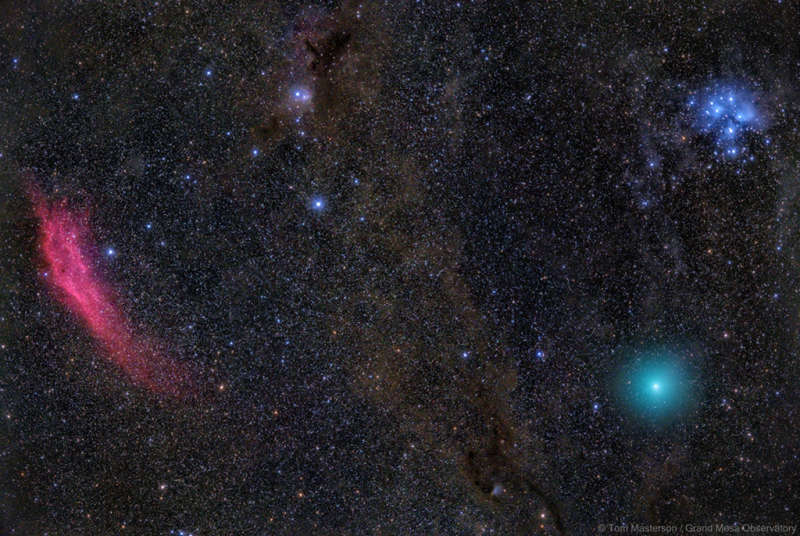Credit & Copyright: Tom Masterson
(Grand Mesa Observatory)
Explanation:
This
festively colored skyscape was captured in the early morning
hours of December 17, following
Comet Wirtanen's
closest approach to
planet Earth.
The comet was just visible to the eye.
The lovely green color of its fluorescing cometary atmosphere
or coma is brought out here only by adding digital exposures
registered on the comet's position below the Pleiades star cluster.
The exposures also bring out blue starlight reflected by the
dust clouds surrounding the young Pleiades stars.
Gaze (toward the left) across dusty dark nebulae along
the edge of the Perseus molecular cloud and you'll
travel to emission nebula
NGC 1499, also known as the California nebula.
Too faint
for the eye, the cosmic cloud's pronounced reddish glow
is from electrons recombining with ionized hydrogen atoms.
Around December 23rd, Comet Wirtanen should be easy to
find with binoculars
when it sweeps close to bright star Capella
in the northern winter constellation Auriga, the Charioteer.
1999 2000 2001 2002 2003 2004 2005 2006 2007 2008 2009 2010 2011 2012 2013 2014 2015 2016 2017 2018 2019 2020 2021 2022 2023 2024 2025 |
Yanvar' Fevral' Mart Aprel' Mai Iyun' Iyul' Avgust Sentyabr' Oktyabr' Noyabr' Dekabr' |
NASA Web Site Statements, Warnings, and Disclaimers
NASA Official: Jay Norris. Specific rights apply.
A service of: LHEA at NASA / GSFC
& Michigan Tech. U.
|
Publikacii s klyuchevymi slovami:
comet - komety - Pleyady - Tumannosti mezhzvezdnye - California Nebula
Publikacii so slovami: comet - komety - Pleyady - Tumannosti mezhzvezdnye - California Nebula | |
Sm. takzhe:
Vse publikacii na tu zhe temu >> | |
